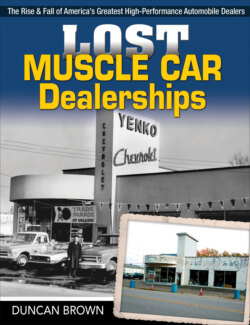Читать книгу Lost Muscle Car Dealerships - Duncan Scott Brown - Страница 29
На сайте Литреса книга снята с продажи.
Dana Camaro Fiberglass Hood
ОглавлениеIn the 1960s, the optional Dana hood was a way to get some weight off the front end while creating a distinctive look for the Dana Camaro. Now, these hoods with the dual square functional air intakes serve as evidence in the unravelling of the origins of Dana 427 Camaros.
A limited number of the very early 1968 Nickey Chevrolet/Bill Thomas Camaros sold in the later part of 1967 and released into the West Coast market were equipped with the same hood that was synonymous with Dana Chevrolet. This was not the norm, as the Nickey Chevrolet Camaros were already being outfitted and campaigned with the Nickey Stinger hood to set them apart from the Dana 427 Camaros. The optional Dana hood links the activities of Bill Thomas to Dana.
The hoods were built by Berry Plasti-Glass, which was located at 2460 Lemon Avenue, Signal Hill, California, about 7 miles from the first Dana location. Berry Plasti-Glass was owned by Richard Berry with son Richard L. Berry as vice president. Berry Plasti-Glass rose to success when Carroll Shelby hired the company to build the Ford GT40, GT40 Mark II, GT40 Mark IIA, and GT40 Mark IV fiberglass body parts.
Berry Plasti-Glass was well-established in the automotive scene, supplying plexiglass dragster windows, lightweight hoods, racing seats, fenders, and other intricate automotive components. It was also instrumental in the development of various fiberglass components for the 1965–1967 Shelby GT350 Mustangs. Peyton Cramer had established a close working relationship with Richard Berry during this campaign, and this relationship influenced the development of what is to be known today as the Dana hood.
Peyton was instrumental in the development and was the conduit through whom those hoods appeared on Dana Camaro 427 cars in May 1967. He was clearly inspired to create a super 427 Camaro based on his experience with Carroll Shelby, who developed super Mustangs with his Shelby GT350. Carroll went all out for the GT500 with a 428 engine, which probably prompted the Dana 427 route. The Shelby influence is very clear in Dana’s use of a unique fiberglass hood.
Berry Plasti-Glass was a father/son team that rose to prominence through its work for Shelby American, which explains the GT40 pictured in this ad. Shelby American alumni Peyton Cramer sourced Berry for the optional hood available on the Dana Camaro. Back in the day, Los Angeles Camaro owners mimicked the Dana Camaro 427 look by installing one of these Berry hoods. (Photo Courtesy Dave Fillion Collection)
Over the next few years, Dana Chevrolet specialized in Corvette sales and service while also unleashing 1967, 1968, and 1969 Camaros packed with 427 engines and chassis upgrades that made them into savage muscle cars that could tear up just about anything else on the road. They also stocked and sold 427 Impalas and small-block Camaros with any hopped-up add-ons.
